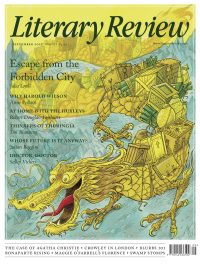Tom Stammers
Making Modernism
If These Apples Should Fall: Cézanne and the Present
By T J Clark
Thames & Hudson 240pp £30
Fans of T J Clark will be fascinated by this latest stop on his sometimes unexpected intellectual journey. A pioneer of the ‘new art history’ in the 1970s, his studies of Courbet and Impressionism electrified by anti-capitalist critique, Clark has in the past two decades revealed himself as a master of patient, attentive looking. His melancholy book The Sight of Death (2006) exemplified this new direction: in it, Clark recorded over several weeks his changing perceptions of two canvases by Nicolas Poussin hanging in the J Paul Getty Museum. Since then, he has wrestled with Picasso’s Guernica, while also extending his engagement with the old masters, offering an idiosyncratic analysis of changing visions of paradise in Heaven on Earth (2018). In this latest publication, on Cézanne, we are back on core Clark terrain, but it is approached with new eyes. Among other things, If These Apples Should Fall is another bravura piece of writing about the experience of looking at paintings. Clark’s heroes among earlier art historians in this very crowded field are Meyer Schapiro and, revealingly, Roger Fry: he is full of admiration for their ‘triumphs of plain style’. In this book, perhaps, we can see Clark’s comfort in reviving discussions of form, structure and pictorial quality familiar to an earlier generation of critics. He even pens poems in response to what he sees.
Of course, Clark knows the historical context extremely well. This is pivotal when it comes to establishing the sequence of works produced by Cézanne during his apprenticeship with Camille Pissarro in the 1870s, and he alludes to issues of class when thinking about the cult of the peasant or the gestural codes of bourgeois portraiture. But such appeals to facts beyond the frame are infrequent and do not resolve issues of pictorial interpretation. That is because Clark’s engagement with Cézanne is far closer to epistemology than to cultural history. Even the citations from Das Kapital do not relate to class struggle but to the bizarre ‘all-one-thingness’ of commodities in capitalism, the reality of which is a kind of fiction rooted in purely symbolic exchange. The quotation points to one of Clark’s chief insights about Cézanne’s art, in which mundane objects can appear at once familiar and impossibly strange, vivid and near but also ‘on the other side of something’. It is not enough, he insists, to describe Cézanne as destabilising the world or throwing everything off kilter; it is the curious interplay of instability and ordinariness that demands explanation.
The book is built around five essays, the central three of which allow Clark to draw out the significance of Cézanne’s interventions in the genres of portraiture, landscape and still life (the last a particular highlight). The first essay explores the genesis of Cézanne’s mature or second style

Sign Up to our newsletter
Receive free articles, highlights from the archive, news, details of prizes, and much more.@Lit_Review
Follow Literary Review on Twitter
Twitter Feed
The era of dollar dominance might be coming to an end. But if not the dollar, which currency will be the backbone of the global economic system?
@HowardJDavies weighs up the alternatives.
Howard Davies - Greenbacks Down, First Editions Up
Howard Davies: Greenbacks Down, First Editions Up - Our Dollar, Your Problem: An Insider’s View of Seven Turbulent...
literaryreview.co.uk
Johannes Gutenberg cut corners at every turn when putting together his bible. How, then, did his creation achieve such renown?
@JosephHone_ investigates.
Joseph Hone - Start the Presses!
Joseph Hone: Start the Presses! - Johannes Gutenberg: A Biography in Books by Eric Marshall White
literaryreview.co.uk
Convinced of her own brilliance, Gertrude Stein wished to be ‘as popular as Gilbert and Sullivan’ and laboured tirelessly to ensure that her celebrity would outlive her.
@sophieolive examines the real Stein.
Sophie Oliver - The Once & Future Genius
Sophie Oliver: The Once & Future Genius - Gertrude Stein: An Afterlife by Francesca Wade
literaryreview.co.uk